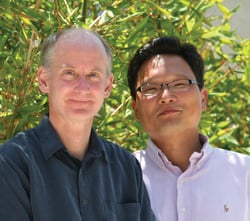QPASS stands for Quantitative Parallel Aptamer Selection System, and bioengineers at the University of California, Santa Barbara (UCSB) and their colleagues at the Morgridge Research Institute in Wisconsin have just received $3.2M to pursue this research into development of a highly efficient system of generating nucleic acid molecules. The end product will be a lab-on-a-chip microfluidic device for instantly detecting disease in a clinical setting, with results that are far more accurate and precise than previous technologies.
 According to Prof. Tom Soh, Co-Director of the UCSB Center for Stem Cell Biology and Engineering (and right in photo):
According to Prof. Tom Soh, Co-Director of the UCSB Center for Stem Cell Biology and Engineering (and right in photo):
“We are developing innovative new technologies that make each step of our process several orders of magnitude more efficient. QPASS will generate high-performance synthetic affinity reagents in a massively parallel manner to meet a growing need in labs and clinics.”
Other engineering, chemistry, and biology researchers involved in this project include renowned biomedical researchers James Thomson and Lloyd Smith, both of whom have appointments at the Morgridge Research Institute in Wisconsin, which in turn is affiliated with UW-Madison. Prof. Thomson (left in photo) is also a Co-Director of the UCSB Center for Stem Cell Biology and Engineering.
Professor Smith, a chemist at UW-Madison, had this to say of the QPASS collaboration and the larger scientific significance of the work with Soh and Thomson:
“This is an exciting project to address a major barrier to progress in biological research: the lack of effective reagents to specifically bind to target proteins that play central roles in cell biology.”
The role of each researcher in the QPASS project will be the following:
- Prof. Soh will engineer a screening tool that uses microfluidics technology to find the best aptamer sequences among trillions.
- Prof. Thomson will integrate sequencing with selection, using computer algorithms to quickly identify the most promising sequences.
- Prof. Smith will use an innovative microarray imaging technology – called Surface Plasmon Resonance Imaging or SPRi – in combination with a microscopic DNA chip that can validate 10,000 times more sequences than current practices, identifying the most effective aptamers instantly.
 Professor Soh is a faculty member within the Center for Bioengineering at UCSB, which will be housed in the new Bioengineering Building beginning construction this year, with completion planned for 2014. The new facility will contain about 48,000sf and will also be home to the Institute for Collaborative Biologies, which is partly funded by the Army and is also a supporter of Dr. Soh's research. We'll post more on the building's progress and its lab facilities in particular as information becomes available in the future.
Professor Soh is a faculty member within the Center for Bioengineering at UCSB, which will be housed in the new Bioengineering Building beginning construction this year, with completion planned for 2014. The new facility will contain about 48,000sf and will also be home to the Institute for Collaborative Biologies, which is partly funded by the Army and is also a supporter of Dr. Soh's research. We'll post more on the building's progress and its lab facilities in particular as information becomes available in the future.
(All images courtesy of UCSB)
Biotechnology Calendar, Inc. will be on the UCSB campus on April 3, 2012 to hold our 4th Santa Barbara BioResearch Product Faire FrontLine event, connecting researchers with the resources they need to further their science research goals. Life science researchers, lab managers, and purchasing agents are actively invited to attend. Potential exhibitors can click the button below for more information on the upcoming show:


